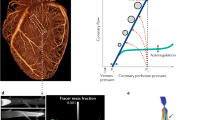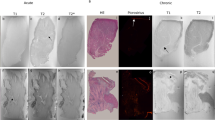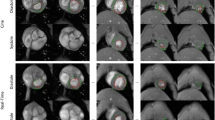Abstract
MRI is emerging as the method of choice for the evaluation of a wide variety of cardiovascular disorders. A major advantage of this technique over the other cardiac imaging modalities is the fact that it allows the operator—via special software programs called pulse sequences—to probe a vast array of biological properties while using the same machine. In this review, we provide the reader with a brief overview of the pulse sequence concept and how it enables MRI practitioners to pursue a multifaceted approach to evaluating the myocardium. We discuss how MRI technology makes this imaging method ideally suited to the assessment of cardiac morphology, contractile function, myocardial perfusion and infarction. In addition, we present clinical scenarios in which the performance of multifaceted imaging by MRI can alter clinical decision making.
This is a preview of subscription content, access via your institution
Access options
Subscribe to this journal
Receive 12 print issues and online access
$209.00 per year
only $17.42 per issue
Buy this article
- Purchase on Springer Link
- Instant access to full article PDF
Prices may be subject to local taxes which are calculated during checkout






Similar content being viewed by others
References
Pennell DJ et al.; Working Group on Cardiovascular Magnetic Resonance of the European Society of Cardiology (2004) Clinical indications for cardiovascular magnetic resonance (CMR): Consensus Panel report. Eur Heart J 25: 1940–1965
Semelka RC et al. (1990) Interstudy reproducibility of dimensional and functional measurements between cine magnetic resonance studies in the morphologically abnormal left ventricle. Am Heart J 119: 1367–1373
Semelka RC et al. (1990) Normal left ventricular dimensions and function: interstudy reproducibility of measurements with cine MR imaging. Radiology 174 (Pt 1): 763–768
Grothues F et al. (2002) Comparison of interstudy reproducibility of cardiovascular magnetic resonance with two-dimensional echocardiography in normal subjects and in patients with heart failure or left ventricular hypertrophy. Am J Cardiol 90: 29–34
Grothues F et al. (2004) Interstudy reproducibility of right ventricular volumes, function, and mass with cardiovascular magnetic resonance. Am Heart J 147: 218–223
Araoz PA et al. (2000) CT and MR imaging of benign primary cardiac neoplasms with echocardiographic correlation. Radiographics 20: 1303–1319
Comeau CR et al. (2001) Ventricular lipoma detection by magnetic resonance imaging. Circulation 103: 1485–1486
Fuster V and Kim RJ (2005) Frontiers in cardiovascular magnetic resonance. Circulation 112: 135–144
Grebenc ML et al. (2000) Primary cardiac and pericardial neoplasms: radiologic-pathologic correlation. Radiographics 20: 1073–1103
Grebenc ML et al. (2002) Cardiac myxoma: imaging features in 83 patients. Radiographics 22: 673–689
Leipsic JA et al. (2005) Cardiac masses and myocardial diseases. In Cardiopulmonary Imaging: Categorical Course Syllabus, 1–13 (Eds McAdams HP and Reddy GP) Leesburg, VA: American Roentgen Ray Society
Mortele KJ et al. (1998) Lipomatous hypertrophy of the atrial septum: diagnosis with fat suppressed MR imaging. J Magn Reson Imaging 8: 1172–1174
Nadra I et al. (2004) Lipomatous hypertrophy of the interatrial septum: a commonly misdiagnosed mass often leading to unnecessary cardiac surgery. Heart 90: e66
Sakarya ME et al. (2002) MR findings in cardiac hydatid cyst. Clin Imaging 26: 170–172
Miralles A et al. (1994) Cardiac echinococcosis. Surgical treatment and results. J Thorac Cardiovasc Surg 107: 184–190
Barkhausen J et al. (2001) MR evaluation of ventricular function: true fast imaging with steady-state precession versus fast low-angle shot cine MR imaging: feasibility study. Radiology 219: 264–269
Helbing WA et al. (1995) Comparison of echocardiographic methods with magnetic resonance imaging for assessment of right ventricular function in children. Am J Cardiol 76: 589–594
Otterstad JE et al. (1997) Accuracy and reproducibility of biplane two-dimensional echocardiographic measurements of left ventricular dimensions and function. Eur Heart J 18: 507–513
Bellenger NG et al. (2000) Quantification of right and left ventricular function by cardiovascular magnetic resonance. Herz 25: 392–399
Zerhouni EA et al. (1988) Human heart: tagging with MR imaging—a method for noninvasive assessment of myocardial motion. Radiology 169: 59–63
Buchalter MB et al. (1990) Noninvasive quantification of left ventricular rotational deformation in normal humans using magnetic resonance imaging myocardial tagging. Circulation 81: 1236–1244
Bellenger NG (2000) Reduction in sample size for studies of remodeling in heart failure by the use of cardiovascular magnetic resonance. J Cardiovasc Magn Reson 2: 271–278
Bellenger NG et al.; CHRISTMAS Study Steering Committee and Investigators (2004) Effects of carvedilol on left ventricular remodelling in chronic stable heart failure: a cardiovascular magnetic resonance study. Heart 90: 760–764
Osterziel KJ et al. (1998) Randomised, double-blind, placebo-controlled trial of human recombinant growth hormone in patients with chronic heart failure due to dilated cardiomyopathy. Lancet 351: 1233–1237
Pennell DJ et al. (1992) Magnetic resonance imaging during dobutamine stress in coronary artery disease. Am J Cardiol 70: 34–40
Baer FM et al. (1994) Coronary artery disease: findings with GRE MR imaging and Tc-99m-methoxyisobutyl-isonitrile SPECT during simultaneous dobutamine stress. Radiology 193: 203–209
Baer FM et al. (1995) Comparison of low-dose dobutamine-gradient-echo magnetic resonance imaging and positron emission tomography with [18F]fluorodeoxyglucose in patients with chronic coronary artery disease. A functional and morphological approach to the detection of residual myocardial viability. Circulation 91: 1006–1015
Baer FM et al. (1994) Gradient-echo magnetic resonance imaging during incremental dobutamine infusion for the localization of coronary artery stenoses. Eur Heart J 15: 218–225
Baer FM et al. (1993) Dobutamine versus dipyridamole magnetic resonance tomography: safety and sensitivity in the detection of coronary stenoses. Z Kardiol 82: 494–503
van Rugge FP et al. (1994) Magnetic resonance imaging during dobutamine stress for detection and localization of coronary artery disease. Quantitative wall motion analysis using a modification of the centerline method. Circulation 90: 127–138
van Rugge FP et al. (1993) Dobutamine stress magnetic resonance imaging for detection of coronary artery disease. J Am Coll Cardiol 22: 431–439
Nagel E et al. (1999) Noninvasive diagnosis of ischemia-induced wall motion abnormalities with the use of high-dose dobutamine stress MRI: comparison with dobutamine stress echocardiography. Circulation 99: 763–770
Hundley WG et al. (1999) Utility of fast cine magnetic resonance imaging and display for the detection of myocardial ischemia in patients not well suited for second harmonic stress echocardiography. Circulation 100: 1697–1702
Wahl A et al. (2004) Safety and feasibility of high-dose dobutamine-atropine stress cardiovascular magnetic resonance for diagnosis of myocardial ischaemia: experience in 1000 consecutive cases. Eur Heart J 25: 1230–1236
Flamm SD (2004) High-dose dobutamine stress cardiac magnetic resonance imaging—has its time come? Eur Heart J 25: 1183–1184
Wilke N et al. (1997) Myocardial perfusion reserve: assessment with multisection, quantitative, first-pass MR imaging. Radiology 204: 373–384
Klocke FJ et al. (2001) Limits of detection of regional differences in vasodilated flow in viable myocardium by first-pass magnetic resonance perfusion imaging. Circulation 104: 2412–2416
Wilke N et al. (1993) Contrast-enhanced first pass myocardial perfusion imaging: correlation between myocardial blood flow in dogs at rest and during hyperemia. Magn Reson Med 29: 485–497
Epstein FH et al. (2002) Multislice first-pass cardiac perfusion MRI: validation in a model of myocardial infarction. Magn Reson Med 47: 482–491
Kraitchman DL et al. (1996) Myocardial perfusion and function in dogs with moderate coronary stenosis. Magn Reson Med 35: 771–780
Schwitter J et al. (2001)Assessment of myocardial perfusion in coronary artery disease by magnetic resonance: a comparison with positron emission tomography and coronary angiography. Circulation 103: 2230–2235
Al-Saadi N et al. (2000) Noninvasive detection of myocardial ischemia from perfusion reserve based on cardiovascular magnetic resonance. Circulation 101: 1379–1383
Lauerma K et al. (1997) Multislice MRI in assessment of myocardial perfusion in patients with single-vessel proximal left anterior descending coronary artery disease before and after revascularization. Circulation 96: 2859–2867
Panting JR et al. (2001) Echo-planar magnetic resonance myocardial perfusion imaging: parametric map analysis and comparison with thallium SPECT. J Magn Reson Imaging 13: 192–200
Wolff SD et al. (2004) Myocardial first-pass perfusion magnetic resonance imaging: a multicenter dose-ranging study. Circulation 110: 732–737
Lee DC et al. (2004) Magnetic resonance versus radionuclide pharmacological stress perfusion imaging for flow-limiting stenoses of varying severity. Circulation 110: 58–65
Meerdink DJ and Leppo JA (1989) Comparison of hypoxia and ouabain effects on the myocardial uptake kinetics of technetium-99m hexakis 2-methoxyisobutyl isonitrile and thallium-201. J Nucl Med 30: 1500–1506
Glover DK et al. (1995) Comparison between 201Tl and 99mTc sestamibi uptake during adenosine-induced vasodilation as a function of coronary stenosis severity. Circulation 91: 813–820
Kim RJ et al. (1999) Relationship of MRI delayed contrast enhancement to irreversible injury, infarct age, and contractile function. Circulation 100: 1992–2002
Fieno DS et al. (2000) Contrast-enhanced magnetic resonance imaging of myocardium at risk: distinction between reversible and irreversible injury throughout infarct healing. J Am Coll Cardiol 36: 1985–1991
Rehwald WG (2002) Myocardial magnetic resonance imaging contrast agent concentrations after reversible and irreversible ischemic injury. Circulation 105: 224–229
Simonetti OP et al. (2001) An improved MR imaging technique for the visualization of myocardial infarction. Radiology 218: 215–223
Wu E et al. (2001) Visualisation of presence, location, and transmural extent of healed Q-wave and non-Q-wave myocardial infarction. Lancet 357: 21–28
Beek AM et al. (2003) Delayed contrast-enhanced magnetic resonance imaging for the prediction of regional functional improvement after acute myocardial infarction. J Am Coll Cardiol 42: 895–901
Schvartzman PR et al. (2003) Nonstress delayed-enhancement magnetic resonance imaging of the myocardium predicts improvement of function after revascularization for chronic ischemic heart disease with left ventricular dysfunction. Am Heart J 146: 535–541
Reimer KA and Jennings RB (1979) The “wavefront phenomenon” of myocardial ischemic cell death. II. Transmural progression of necrosis within the framework of ischemic bed size (myocardium at risk) and collateral flow. Lab Invest 40: 633–644
Choudhury L et al. (2002) Myocardial scarring in asymptomatic or mildly symptomatic patients with hypertrophic cardiomyopathy. J Am Coll Cardiol 40: 2156–2164
McCrohon JA et al. (2003) Differentiation of heart failure related to dilated cardiomyopathy and coronary artery disease using gadolinium-enhanced cardiovascular magnetic resonance. Circulation 108: 54–59
Moon JC et al. (2003) Toward clinical risk assessment in hypertrophic cardiomyopathy with gadolinium cardiovascular magnetic resonance. J Am Coll Cardiol 41: 1561–1567
Schuster EH and Bulkley BH (1980) Ischemic cardiomyopathy: a clinicopathologic study of fourteen patients. Am Heart J 100: 506–512
Boucher CA et al. (1979) Cardiomyopathic syndrome caused by coronary artery disease. III: Prospective clinicopathological study of its prevalence among patients with clinically unexplained chronic heart failure. Br Heart J 41: 613–620
Shah DJ et al.: Magnetic resonance of myocardial viability. In Clinical Magnetic Resonance Imaging, edn 3 (Eds Edelman RR et al.) New York, NY: Elsevier, in press
Hurwitz JL and Josephson ME (1992) Sudden cardiac death in patients with chronic coronary heart disease. Circulation 85 (Suppl): SI43–SI49
Kim RJ and Judd RM (2003) Gadolinium-enhanced magnetic resonance imaging in hypertrophic cardiomyopathy: in vivo imaging of the pathologic substrate for premature cardiac death? J Am Coll Cardiol 41: 1568–1572
Maron BJ et al. (1986) Intramural (“small vessel”) coronary artery disease in hypertrophic cardiomyopathy. J Am Coll Cardiol 8: 545–557
Acknowledgements
RJ Kim and RM Judd were supported by grants from the National Institutes of Health (NIH).
Author information
Authors and Affiliations
Corresponding author
Ethics declarations
Competing interests
Raymond J Kim and Robert M Judd are inventors of a patent on delayed-enhancement imaging, which is owned by Northwester University, Chicago, IL, USA
Rights and permissions
About this article
Cite this article
Shah, D., Judd, R. & Kim, R. Technology Insight: MRI of the myocardium. Nat Rev Cardiol 2, 597–605 (2005). https://doi.org/10.1038/ncpcardio0352
Received:
Accepted:
Issue Date:
DOI: https://doi.org/10.1038/ncpcardio0352
This article is cited by
-
The scar: the wind in the perfect storm—insights into the mysterious living tissue originating ventricular arrhythmias
Journal of Interventional Cardiac Electrophysiology (2022)
-
PDE-constrained optimization in medical image analysis
Optimization and Engineering (2018)
-
Left ventricular fat deposition on CT in patients without proven myocardial disease
The International Journal of Cardiovascular Imaging (2013)
-
Comparison of cardiovascular magnetic resonance of late gadolinium enhancement and diastolic wall thickness to predict recovery of left ventricular function after coronary artery bypass surgery
Journal of Cardiovascular Magnetic Resonance (2008)
-
Targeted imaging of myocardial damage
Nature Clinical Practice Cardiovascular Medicine (2008)



